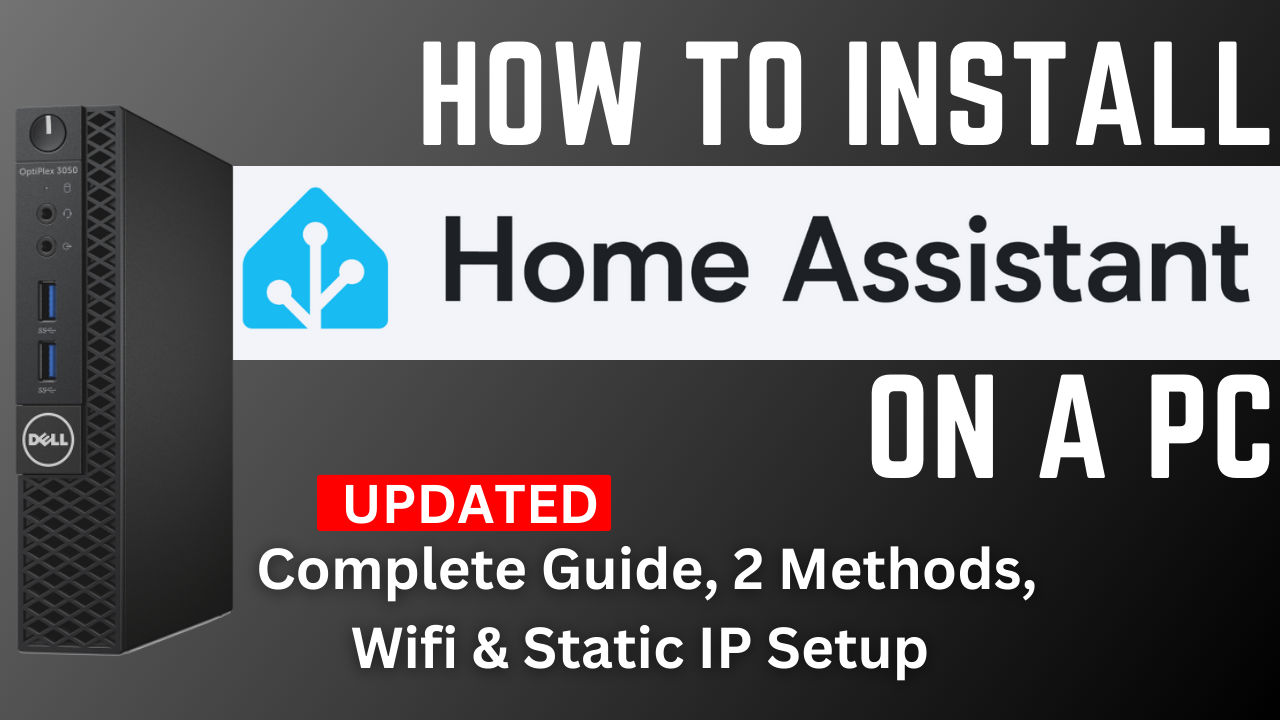How to Install Home Assistant Operating System on a PC (Updated)
A refresh on my Home Assistant PC installation video! Now featuring call outs, tips, and lessons learned for a smoother setup. Prefer shorter tutorials? Check out shorter method-specific videos to get straight to the point!

Hello and Welcome to Chuck Builds,
One of my earliest guides and videos on this channel was about How to Install Home Assitant on a PC but one of the steps inside of Ubuntu has changed as BalenaEtcher no longer works reliably inside of Ubuntu. I had uploaded a quick fix video but figured I could do better and remake the whole video with a LOT more detail. This is an attempt at a written guide to support the videos.
Before I dive in, I want to call out that I made 3 videos on the below content, a Complete Version, a Method 1, and a Method 2. I am writing this written guide to cover all 3 of these videos but if you are only interested in the steps of your Method, please skip ahead.
First, What is and Why Home Assistant Operating System?
Home Assistant is a smart home software that brings together many different products into one place and enables you to control and automate these products. What makes Home Assistant special is the community, the size, and the support it offers. On Home Assistant, we are not locked down to any one technology, one manufacturer, or one ecosystem. We can combine multiple 3rd party "Smart Homes" into one place and write complex automations or download community made addons to bring a TON of functionality to our smart home. The sky is the limit for Home Assistant.
However, Home Assistant is not some program you can run on it's own like an .exe application executable. There are multiple ways to run it, and this guide is specifically focused on a Bare Metal installation of HomeAssistant onto a Dedicated Host. What does this mean? It means that we need to dedicate a piece of hardware to ALWAYS be online, running HomeAssistant, which we will accomplish by running the HomeAssistant Operating System on the host PC. AKA we will be replacing Windows with Home Assistant and letting it run JUST Home Assistant. There are other ways to host Homeassitant, such as a VM or Docker Container, and this allows you to share the designated Host's resources with other processes and applications, but for a beginner this will be the easiest way and minimize the steps and complication of the whole system.
Second, What are the differences between the two Methods in this Guide?
The Official HomeAssistant Documentation ( HomeAssistant Installation Guide) calls out 2 methods, so I wanted to be sure to cover both. The Primary Difference between the two is your willingness to take apart your host and your willingness to potentially purchase additional hardware. I personally recommend Method 1, as it only requires a USB drive and a few additional steps. Method 2 would require removing your drive, having the ability to do so and identify your drive, and purchase the necessary adapter to connect it to your existing PC and write directly to it.
Method 1: Use a USB drive to Boot into Ubuntu Operating System and then write HAOS to your target host.
Method 2: Remove the drive from your target host, connect to your PC, and write HAOS directly to the drive, re-install drive on PC.
Need to Purchase a USB Drive or Adapter?
Consider using one of my Amazon Affiliate links Amazon where I receive a small commission if you purchase using my links:
- Amazon 128GB USB Drive $15 (https://amzn.to/3uSDeCK)
- Sata to USB Adapter $11 (https://amzn.to/48EnqBg)
- M.2 to USB-C Adapter $20 (https://amzn.to/3UX8Q4Q)
Regardless, you need to make BIOS Changes
Home Assistant officially only requires 2 BIOS changes but I've got a few others I recommend. In order to enter your BIOS, press the corresponding key while your PC is turning on. If you don't see anything on the screen, you can try F1, F2, F11,F12, ESC, or DEL - which are common keys to enter BIOS. If these don't work you might need to google and see what key is for your specific device.
Home Assistant Requires
- UEFI Boot Mode to be Enabled
- Secure Boot to be Disabled
But I also Recommend:
- Ensure Turbo Boost is On
- Ensure Multi-Core Support is enabled
- Ensure Sleep is Disabled
- Set AC Recovery - I prefer the "Last Power State" Setting
- Ensure your USB ports are enabled
- Ensure that your SSD is showing
Method 1:
Step 1: Download Ubuntu from https://ubuntu.com/download/desktop
Step 2: Download BalenaEtcher (Or Alternative)
- Balena Etcher Download: https://etcher.balena.io/
- Rufus Download: https://rufus.ie/en/
- PenDriveLinux : https://pendrivelinux.com/universal-usb-installer-easy-as-1-2-3/
Step 3: Write Ubuntu to USB Drive
Step 4: Setting BIOS Boot Order for USB to boot First (ensure UEFI Boot Mode)
Step 5: Booting into Ubuntu and connect to the Internet
Step 6: Download Home Assistant OS Image from https://www.home-assistant.io/installation/generic-x86-64#method-1-installing-haos-via-ubuntu-booting-from-a-usb-flash-drive
Step 7: Write HomeAssistant OS Image to USB Drive
Step 8: Boot into HomeAssistant OS
Method 2:
Step 1: Remove SSD from PC
Step 2: Download HomeAssistant OS image from : https://www.home-assistant.io/installation/generic-x86-64#method-1-installing-haos-via-ubuntu-booting-from-a-usb-flash-drive
Step 3: Download Rufus(Or Alternative)
- Balena Etcher Download: https://etcher.balena.io/
- Rufus Download: https://rufus.ie/en/
- PenDriveLinux : https://pendrivelinux.com/universal-usb-installer-easy-as-1-2-3/
Step 4: Write HAOS Image to Drive
Step 5: Replace SSD in PC
Step 6: Boot into HAOS
First Boot:
Wifi Setup:
- Type "network info" no quotes to see if your network hardware information
- Ensure you have a wireless network interface available, it will start with "w", in the above screenshot mine is "wlp2s0"
- Type "network update WIRELESSINTERFACENAMEHERE --ipv4-method auto --ipv6-method auto --wifi-auth wpa-psk --wifi-mode infrastructure --wifi-ssid WIFI-NAME --wifi-psk WIFI-PASSWORD" without those quotes. If your wifi name or password has a space use quotes.
Fix Flash Drive after installing HomeAssistant:
- Open your Start Menu and type CMD to open Command Prompt
- Type "diskpart.exe" (no quotes) and then press enter
- Inside of Diskpart (new window should've opened) type "list disk" (again with no quotes)
- Identify the disk that is your flashdrive. This is easily done by looking at the storage size and making sure it matches that of your USB Flash Drive.
- Type "Select disk #" (no quotes) replacing # with the number of the disk from diskpart.exe
- Type "Clean" (no quotes)
- Type "create partition primary" (no quotes)
- Type "Select Partition 1" (no quotes)
- Type "Format Quick"
